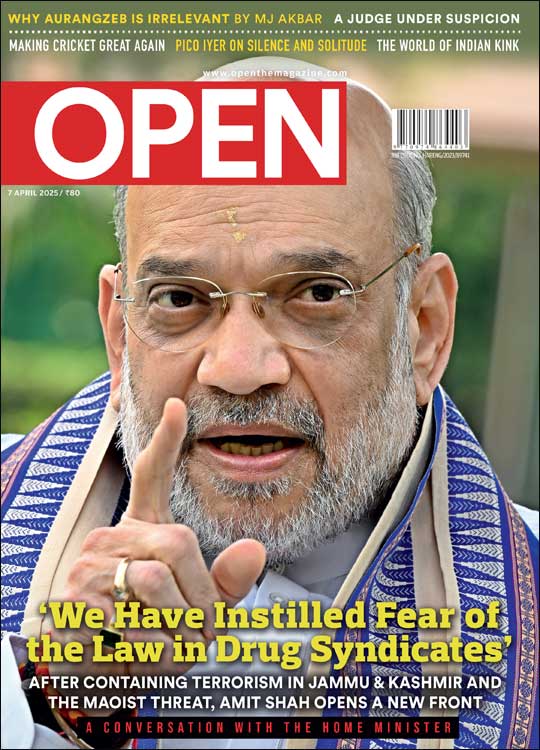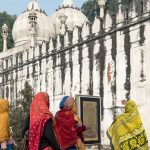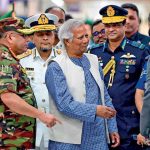DNA Is Destiny
A genetic history of Indian ancestry
 Madhavankutty Pillai
Madhavankutty Pillai
 Madhavankutty Pillai
Madhavankutty Pillai
 |
24 Dec, 2015
|
24 Dec, 2015
/wp-content/uploads/2016/01/20442.dna1_.jpg)
For someone who started off interested in fruit flies in Varanasi, Gyaneshwer Chaubey, now with the University of Tartu in Estonia, has travelled some distance, both literally and metaphorically. While doing his MSc, Chaubey had done a project in the Cytogenetics Laboratory of Benaras Hindu University where he found the drosophila (or fruit fly) interesting enough to decide to do a PhD on it. But that determination changed in the last semester, when all students had a six-month dissertation assignment at different research institutions. Where they could go would depend on their ranking, and the Centre for Cellular and Molecular Biology (CCMB) in Hyderabad was reserved for toppers. In Chaubey’s class, all the toppers were girls and the course of his career might have been different if not for the CCMB assignment involving a lot of fieldwork to collect blood samples. The girls were not keen on it, and so Chaubey, who was the topper among boys, found himself at the institute.
When he submitted his dissertation at CCMB, he was still leaning towards the fruit fly, but the week that he was to leave the institute, he came across a paper that had just been published. Titled ‘The Genetic Heritage of the Earliest Settlers Persists Both in Indian Tribal and Caste Populations’, its lead author was Toomas Kivisild of Tartu University, and this study had looked at the genes of two south Indian tribal groups and compared it with six caste groups across India. Their conclusion was that most Indian tribal and caste populations had the same genetic heritage going back to the Pleistocene era—more than 11,000 years ago. Reading it, says Chaubey, ‘turned 180 degrees’ his earlier views on the peopling of India and even his own antecedents. Till then, he had believed he descended from Aryans who had come from Central Asia.
Chaubey then extracted his own DNA to examine where his genetic origins lay. ‘I was surprised to see that both my maternal and paternal ancestries were from South Asia itself. And this was the major turning point of my life, as [I switched to] a completely different and [more] complex field of genetics called Molecular Anthropology,’ he says in an email interview.
DNA is the genetic information that governs our body. It exists as strands in the nucleus of every cell, a double helix with rungs like a ladder. These rungs are made of four molecules and the permutations and combinations of their arrangement make up the code that determines our physical, mental and even emotional functions. Humans receive half their DNA from each parent, which means everyone has a new full set of nuclear DNA. But there is also something called mitochondrial DNA (mtDNA) located outside the cell’s nucleus. This is received only through the mother and so stays unchanged over the generations along a person’s matrilineal descent. Your mother, grandmother, great grandmother and so on all have the same mtDNA. Similarly, males have a Y chromosome that gets passed down intact from fathers to sons. This chromosome’s DNA is called Y-DNA and this too remains unchanged from generation to generation of men. Anyone who looks at mtDNA or Y-DNA is seeing pristine genetic information that goes back right to the beginning of mankind.
But MTDNA and Y-DNA do change once in a rare while when there is a small mutation in them, and this offers geneticists a tool that can be used to go back to the past. One of the molecules in an individual’s mtDNA or Y-DNA might get replaced by another and then all future offspring of that person will carry this small marker. By looking at these markers, researchers can find out when and where it happened and trace the genesis of a population group. There will, for example, be a set of markers that are specific to Indians. The researchers would then look at another foreign group, like European gypsies, and find that they share many markers with Dalits, suggesting that some caste groups of India might have migrated Westwards and become gypsies.
Chaubey went on to work with Dr Kivisild as his PhD student, but the offer came with a warning— that Tartu is going to be extremely cold and the scholarship for PhD students would be €384 per month for 10 months. “I told him that if he offers me two-time food, I’ll be very happy to join him,” he says. A list of papers connected to India that he has been part of since then shows the extent to which genetics is now encroaching on research traditionally governed by social sciences like archaeology, anthropology, linguistics or even history. One of Chaubey’s earliest papers found that a majority of the maternal lineages of South Asians originated in the Subcontinent itself.
Then there was a study on a caste group, Musahar, with whose members he used to play cricket as a child. “From childhood I was curious about them as some of them were bilingual and used to speak both Indo-European (spoken in Europe, Central and South Asia) and Austro-Asiatic (spoken mainly in south East Asia) languages. We studied them and found it a case of ‘language shift’ where they have changed their language rapidly [while] keeping intact their genetics,” he says. Musahars had gone from speaking Munda, an Austro-Asiatic language, to Hindi, an Indo-European language. But when their mtDNA and Y-DNA were compared to neighbouring Indo-European and Austro-Asiatic populations, the genetic affinity was closer to the former. ‘This example shows that the language shift as such is not necessarily a signal for a rapid genetic admixture, either maternally or paternally,’ noted the paper. “Then with archaeologist Professor Mike Petraglia, we found that there was a major revolution of microlithic (small stone tools) technology 35,000 years ago in South Asia which has deeply affected its human demography,” says Chaubey.
He has been part of a worldwide study of Jews in which the researchers inferred a common ancestry for Indian Jewish populations and also studied how Siddis, Africans brought in as part of the slave trade by the Portuguese, had mixed with India’s local inhabitants.
Around 60,000 odd years ago, a group from Africa decided to finally move out of the continent, and that first migration began the peopling of the human race across the earth. Some of them trekked all the way to India through a southern coastal route and then further to the Andaman and Nicobar Islands. This is a group that is called the Ancestral South Indians (ASIs) and almost all Indians have genetic markers from this branch. A large proportion of Indians, however, also have markers that are common to Europeans, Central Asians and Middle Easterners, and this is believed to be the result of a second wave of migration around 20,000 years later, where one group went to Europe and the other came to India through the Middle East. The group that came to India then is referred to as Ancestral North Indians (ANIs).
Kumarasamy Thangaraj, a senior principal scientist at CCMB, has done a number of studies around this hypothesis. As an author, his name features on many national and international research papers related to Indian populations. Over the last 15 years, CCMB has painstakingly collected over 20,000 samples of DNA from people all over India, including some very remote and inaccessible regions. In their systems, they have stored very carefully the details of each sample: where it was collected, the name of the tribe or caste of the person, etcetera. This vast database of genes is the raw material for various studies.
One of Thangaraj’s early papers was on Andamanese tribals. “Nobody had explored their genetic information. We showed that they are the first modern humans who migrated out of Africa, taking the southern coastal route and reaching Andaman and Nicobar Islands about 65,000 years back.
Earlier there was archaeological evidence, but it was not very well established. Ours was the first genetic study which showed this,” he says.
In 2009, another study that he was part of in collaboration with Harvard University and which was published in the journal Nature, talked about how all Indians had emerged from ASI and ANI founding populations. They looked at genetic information of 25 Indian groups categorised by caste, tribe, language, region and then also included European, African and Chinese samples in the analysis. The Africans, Europeans and Chinese were all homogenous in their genes. Each group among the Indians, however, formed a distinct but closely organised cluster. Thangaraj compares it to a pearl necklace where beads are strung together closely with a thread running through them. Likewise, there was a common thread of genetic markers running through all Indian groups. It indicated that in the beginning, there were many separate groups who then intermixed. “There was a uniqueness of every Indian population, but there was also a relationship between the groups. That indicates there is an admixture between population groups, otherwise every group should have clustered very differently,” he says.
In 2013, he was part of another study in association with Harvard, which again looked at a large number of samples from south and north India and tried to see how long back this mixing of Indian populations happened. “In every generation, half of the genetic material from fathers and mothers goes to the next generation. Based on the recombination frequency, we predicted, using a large number of samples, that the last 2,000 to 4,000 years there was an admixture,” he says.
This is how it might have gone: the Ancestral South Indians came to India and settled in various places in groups, isolated from each other. The Ancestral North Indians came later and their groups began to live separately. Around 4,000 years back, there began large scale intermixture. But the story doesn’t end there. About 2,000 years later, this mingling began to reduce. This the paper attributes to the coming of endogamy or the practice of marriages only happening within a group. This idea comes with an interesting possibility: that if such endogamous marriages arose, then caste as an Indian phenomenon also possibly had its genesis around that period. It could explain the sudden end of Indian groups mixing with each other.
Genetic studies are now beginning to also find out why we are how we are. Chandana Basu, one of Chaubey’s colleagues at University of Tartu, was recently part of a paper that looked at a gene called SL24A5. This gene makes Europeans fair- skinned, but they found that even 27 per cent of Indians had a light complexion because of it.
Says Basu over email, ‘We knew there was a significant gap of knowledge with regard to the genetic basis of skin pigmentation among Indian populations, who we know are diverse in skin colour. When we started our study, there were only two studies based on Indian populations living in USA and UK but none on ethnic Indians. Therefore, we thought India would be a perfect model to study the genetic underpinnings of skin colour variation.”
Another objective of the study was to spot where and when this mutation originated. ‘We could not find where it originated but we found that carriers of the varied form of the mutation (from Europe, sub-Saharan Africa, Middle East, South, North and Central Asia) share it from a common ancestor whom we hypothesise to have lived 21-28,000 years ago,’ she says. If someone in India is fair-skinned, then there is therefore a possibility that it is the result of a small change in a gene that someone underwent 25,000 years ago.
Another instance of genetic studies trying to understand the Indian body is a paper of Thangaraj published in Nature in October 2015. The researchers looked at Indian body constitutions according to Ayurveda to determine whether genetics backed it up, selecting 262 men who had already been classified into one of three categories—Vata, Pitta and Kapha—by Ayurvedic physicians and a software application called Ayusoft. They found different clusters of genetic markers for each of them. “We identified 50 genetic markers which can differentiate these three Ayurvedic classifications,” he says.
Chaubey has also examined the ancestry of his own village. According to an oral tradition, they had migrated from Gorakhpur district to Varanasi around 600 years ago, and when he analysed the genetic data he found that two major founders of his village shared a common ancestry 700 years ago. “In fact, my next plan is to use these oral traditions of people and try to identify the ancestral population of ancient Varanasi and see how it was structured before. [For] 10 years, [I have been] working on the caste system by analysing Brahmin populations from all over India along with their gotras, intermarriages and structuring, but I see that it is too complex and may need one more year to reach some firm conclusion,” he says.
He says such information can be gleaned from DNA because technology has advanced rapidly and become cheap; the complete genome of a person can be done for about Rs 1.5 lakh, and the data allows us to reconstruct the details of his or her population, food habits and even physical structure.
What genetic studies are saying, according to him, is often unexpected. “On India, to our big surprise, most of the established pre-historical information was not supported by the DNA analysis. For example, the common peopling [theory] says that Austro-Asiatics are the [most] ancient settlers, then Dravidians came from Mesopotamia (modern Iran) and Aryans came as invaders at the end, whereas in Genetics we found that the Austro-Asiatic tribes came from the East (Southeast Asia) just 5,000 years ago, Dravidians are indigenous and there is no sign of an Aryan invasion even in higher caste people,” he says.
But there is more to genetic studies on populations than satisfying our curiosity. It has enormous implications for future medical treatment. Once the genetics of specific groups are understood, then medicines aimed especially at them can be created. This is particularly true for India, where endogamous marriages and the caste system have led to genes staying contained within closed pools, resulting in the occurence of many recessive-gene ailments specific to them. Genetic information on the group can give us techniques to better identify these diseases at an early stage and design treatments.
One study that Thangaraj was part of showed that 4 per cent of South Asians carried a gene that increased their risk of heart failure. “It is prevalent only in India and South Asia, but not in other countries. Similarly, there are many mutations existing in India that have not been reported. Unless we explore all these, we cannot come up with any strategies or drugs for controlling these diseases,” he says.
About The Author
CURRENT ISSUE
‘We Have Instilled Fear of the Law in Drug Syndicates,’ says Amit Shah
MOst Popular
4

/wp-content/uploads/2025/03/Cover_Amit-Shah.jpg)











More Columns
BJP allies redefine “secular” politics with Waqf vote Rajeev Deshpande
Elon Musk attracts sharp attack over ‘swastika’ from Indians on social media Ullekh NP
Yunus and the case of a "land locked" imagination Siddharth Singh